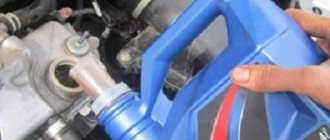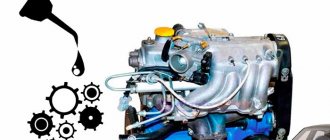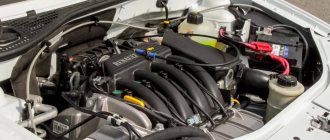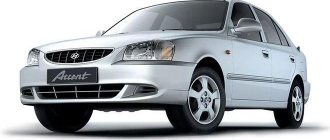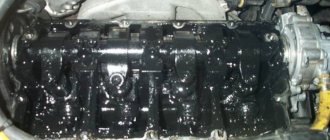What kind of oil to fill in a Hyundai Accent so that the “heart” of the car lasts for many years, we will deal with this issue on this page. Motor oil is used to ensure normal engine functionality and protect it from wear. When the oil loses its properties, it stops lubricating the main components of the engine.
The most important thing in changing the oil is choosing the right product! We will tell you what oil to choose, what tolerances it must meet, and most importantly how and how much to fill it with!
About tolerances Let's consider which oil tolerances are suitable for Accent
As you can judge from this table, most often the tolerance 5W20 and 5W30 is suitable and is recommended in our country for used cars!
It is also possible to use semi-synthetic oils with a viscosity of 10W40!
Engine oil for Hyundai Accent 1.5?
To use oil in Accent 1.5, you can take any with viscosity indicators 5W20, 5W30, 5W40. Specialists from the Hyundai plant advise using exactly this sequence of searching for motor fluid. If there is no lubricant of the 5W20 class, then the use of the 5W30 class is allowed.
For example, product:
- MOTUL 8100 X-clean
perfect for Hyundai Accent, or you can choose any other product from our list or a product with a suitable approval. Among inexpensive analogues, an excellent option would be
- Lukoil Lux 5W30
How to avoid encountering counterfeit Hyundai oil
Factors that influence choice
Very often, the automaker gives clear recommendations on the use of lubricant. A list of products suitable for this model is included in the vehicle model's owner's manual. In accordance with it, Hyundai Accent units should be filled with 5W30 and 5W40 fluid. If the mileage is more than 200,000 km, a viscosity of 10W40 is suitable.
Factory recommendations apply to specific models and are recorded in the manual. But not everywhere in reality it is possible to strictly follow the recommendations of the car manufacturer. Often it requires adjustment from a specialist or an independent conclusion as to which fluid is suitable for the engine of a given car. When choosing a lubricant for Hyundai, many indicators should be taken into account, including the volume of the unit, its number, and the year of production of the unit. In addition, the manufacturer's recommendations and filling volume should be taken into account. The listed parameters should be taken together.
What is the replacement interval?
The frequency of oil changes in a Hyundai Accent directly depends on the year of manufacture of the car. Hyundai older than 2004 requires updating consumables at least every 10 thousand kilometers.
Liquid can lose its useful characteristics for some reasons:
- the season of car use when temperature changes occur;
- driving style - gentle or aggressive;
- the rate of work the engine performs;
- duration of use of the engine during traffic jams;
- quality of roads;
- engine capacity;
The listed factors significantly reduce the service life of engine oil, regardless of the mileage traveled by the car. During intensive use, experts recommend changing the oil every six months or every 10-12 thousand km!
Automatic transmission also requires maintenance!
In Russia and other CIS countries, there is a misconception related to the fact that the oil in the automatic transmission does not need to be changed, they say it is filled for the entire period of operation of the car. What is the service life of an automatic transmission? 100,000 kilometers? 200,000 kilometers? Who will answer this question? That's right, no one. Dealers say one thing (“filled for the entire period,” but they don’t specify the duration of what), the neighbor says something else (they say he has a friend who “changed the oil in the box and it closed after that,” of course, if problems have already begun, they are irreversible and oil is not the solution). We would like to draw your attention to the fact that routine maintenance of an automatic transmission extends the life of the transmission by 2 or even 3 times .
Most car concerns do not produce automatic transmissions, but install units from global transmission manufacturers such as ZF, JATCO, AISIN WARNER, GETRAG and others (it is worth noting the fact that Kia/Hyundai develop and produce THEIR own transmissions). So, the accompanying notes for their units from these companies state that the oil in the automatic transmission requires replacement every 60,000-100,000 kilometers. There are even rem. kits (filter + gasket) and specialized oil called ATF, from the same manufacturers. To find out more about what oil to fill in the Hyundai Accent automatic transmission, as well as service intervals, tolerances and additional information, follow the link.
Level control and required volume
It is important to know exactly how many liters need to be poured into the power unit. If the amount of lubricant is insufficient, this will lead to malfunctions in the operation of the machine’s motor. And the excess volume of liquid will cause the sealing elements and seals to be squeezed out. In addition, if there is an excess, the level of combustion of additives and lubricants in the internal combustion engine cylinders will increase. All unburned elements will eventually reduce the efficiency of the catalyst, settling on its internal surfaces. The exact volume poured into the motor is indicated in the technical manual for the machine. How much car owners pour into the internal combustion engine depends on the year of manufacture, as well as the modification of the vehicle. On average, 4.3 liters is enough to fill the engine.
The fluid level is checked on a cold engine. Open the hood of the car and find the diagnostic dipstick; it is installed in a special hole on the cylinder block. Take it out and wipe it with a rag, then put it back in and pull it out again. Ideally, the fluid level should be between the Min and Max marks.
Possible causes of oil consumption
What factors influence increased engine fluid consumption:
- Overfilling of lubricant. This causes increased fluid consumption. The crankcase ventilation system of the internal combustion engine will begin to squeeze out excess volume from the power unit.
- Leakage of lubricant from irregularities and areas damaged by corrosion.
- Constant operation of the vehicle at high speeds, especially during running-in of the power unit.
- Fluid viscosity class mismatch. If this parameter is too high, the combustion of the lubricant will occur more slowly.
- Accelerated wear of power unit components. Oil control valves fail, and gaps may appear on the valve sleeve and stems. Piston rings, etc. wear out.
The main reason for rapid consumption is usually the loss of liquid. The greater the number of pistons in the internal combustion engine, the faster the unit will consume oil.
According to experts, one overheating of a machine motor can lead to the unit starting to eat lubricant.
One of the biggest problems is leakage. Fluid can leave the lubrication system from under the valve cover, cylinder head gasket, filler neck seal, or drain hole. Often, lubricant leaks out from under the camshaft and crankshaft seals, oil filter or oil pan gasket. Leak locations can be determined by visual diagnostics. If it was not possible to identify the cause by eye, then most likely the engine is eating lubricant as a result of wear on the piston rings or valve stem seals.
Changing the oil in the Hyundai Accent engine
To change engine oil in a Hyundai Accent you will need:
- Engine oil
- Drain plug or o-ring
- Oil filter
To change the oil, warm up the engine to operating temperature, drain the used oil, change the drain bolt or drain bolt gasket, replace the oil filter, and fill in engine oil based on the volume specified for your engine.
Video materials (guide):
Engine 1.5
Accent (Tagaz)
In Russia, the TagAZ plant produced passenger cars of the Accent family, and they belonged to two different generations. The engines installed on them were also different, but in reality we are talking about similar versions of one engine - G4EC . Therefore, the same oil can be poured into the Hyundai Accent engine - the choice does not depend on the year of manufacture. However, there is a more precise approach to this issue.
Filter and drain plug
When changing the oil, the oil filter and oil drain plug with sealing gasket must be changed. The table shows original filters and plugs, as well as their analogues from well-known manufacturers, indicating the catalog numbers of spare parts.
| Manufacturer | Part number according to the catalog |
| Oil filter | |
| Hyundai | B17003H |
| Bosch | 0 451 103 316 |
| Ashika | 1007703 |
| And | 40129003 |
| Japanese cars | B17003 |
| Besf1ts | FL1006 |
| Bosch | 0 451 103 316 |
| Chrysler | MZ690150 |
| Jakoparts | J1317003 |
| Js asakashi | C307J |
| Japanparts | FO703S |
| Mann | MW810 |
| Mando | MOF4459 |
| Mitsubishi | MZ690150 |
| Maxgear | 26-0272 |
| Nipparts | J1317003 |
| Motorparts | 15400-PR3-003 |
| Sakura | C1016 |
| Profit | 1540-0740 |
| Vic | C-307 |
| Toko cars | T1116003 |
| Drain plug | |
| Hyundai | 2151323001 |
| Ajusa | 18001100 |
| Elring | 726760 |
| Febi | 30181 |
| Kia | 21513-23001 |
| Mitsubishi | MD050317 |
| Mobis | MOB2151323001 |
| Onnuri | 21513-23001 |
| Pmc | P1Z-A052M |
Information from official literature
Let's open the TagAZ brochure and see what the manufacturer recommends.
The following materials are suitable for 16-valve valves with a volume of 1.5 liters:
- viscosity : 10W-40, 5W-30 or 5W-40;
- ACEA quality: A3/B3 or A3/B4;
- Important! HTHS Viscosity: 3.5 mPas or more.
SAE viscosity grade is selected according to climate:
- -25 – +35: 10W-40;
- -30 – +25: 5W-30;
- -30 – +35: 5W-40.
That's all. But this information is not enough for practice.
What do we pour (editorial emphasis)
Shell Helix Ultra 5W-40 (synthetic) - the price tag bites. But in the 5 years that we’ve had the Accent, we haven’t had any problems with the engine!
Adviсe
To top up, use the same material with which the system is already filled. If you don’t know the brand (brand), you need to perform a complete replacement. Follow the rules:
- Semi-synthetics were always poured at service stations. And when choosing which oil to pour into the Hyundai Accent next, it is better not to switch to “pure synthetics”.
- The oil brand will most likely change after the change. Do this: use the new oil as flushing oil. That is, they drive with it for one day, and then the replacement is repeated.
- The filling volume for the G4EC internal combustion engine rarely exceeds 3.35 liters.
Be careful with the HTHS ratio! Belonging to class A3 entails meeting the requirement “HTHS>3.5”, but not all oils are classified according to ACEA...
This kind of oil is possible.
For the ILSAC GF-4 class, corresponding to “the middle between A3 and A5”, the requirement “HTHS>3.5” is not always met. For 5W-30 oils, for example, the HTHS rating is often " 2.9».
Recommendations from service representatives
Up to 100,000 km - one oil, after - a different type and viscosity. Editorial Accent in the photo. We use Shell Helix Ultra 5W-40 (not an advertisement, but advice).
- If the mileage exceeds 100 thousand, the best choice would be 10W-40 oil. The consumption of material with this viscosity tends to a minimum. It seems that the recommendation looks reasonable, but only if the car is not operated at -27 - -30 C.
- When switching from one type of oil to another, flushing is mandatory . It is carried out at least as indicated above. The advice applies even to “pure synthetics” - all additives must be removed from the system. If after replacement the fuel consumption increases noticeably, it means that the system was not properly flushed. Owners call the figure “+2 liters per hundred,” but here you have to wonder whether the oil was fake.
Features of different types of oils
The working surfaces of the engine are constantly in friction, which contributes to their gradual wear, the formation of scoring, cracks and many other problems. High temperatures constantly affect engine parts, especially when the engine is running at full power.
The car engine operates in constantly changing environmental conditions, resulting in metal corrosion, which has destructive power. Soot and carbon deposits formed during fuel combustion negatively affect the engine as a whole. High-quality motor oil helps to cope with the following problems: lubrication of surfaces of parts, reduction of friction force, ease of movement, cleanliness of parts from soot and soot, removal of combustion products.
Lubricating the surface layer of engine elements protects them from corrosion. Therefore, specialists from leading oil manufacturers continue to work on their quality, trying to achieve improvements so that each component becomes special and unique. There are several types of motor oils:
- mineral;
- synthetic;
- semi-synthetic.
Mineral motor oil is a natural petroleum product. Synthetic - obtained as a result of synthesis. Semi-synthetic is an engine oil made from mixing mineral and synthetic. Every motorist should know: synthetic ones are least exposed to low temperatures and overheating, and retain their characteristics longer during operation.
Drivers see a temperature indicator on the instrument panel and consider it an indicator of engine heating, but this reading belongs to the coolant. Its temperature in a warm engine is stable and reaches approximately 90°. The engine oil temperature fluctuates and can reach 150°. This mark depends on the speed and intensity of movement.
The optimal volume of engine oil should ensure maximum efficiency with minimum wear of engine parts, taking into account the influence of ambient temperature. The variable number of motor oil is viscosity. Thanks to it, the oil is able to linger on the surface of the engine components and maintain fluidity. It must be of a certain viscosity and correspond to the technical characteristics of the machine. Each engine has its own optimal viscosity standards, which is an individual indicator for the car.
Semi-synthetic - has constant characteristics. It is of higher quality than mineral, but lower in properties than synthetic. Semi-synthetics are proposed to be poured into the engine of a modern car with significant mileage. There are certain requirements for the chemical composition of motor oils, so when they are mixed, a chemical reaction may occur, and it is unknown how the additives used in these oils will behave.
Mixing motor oils is an exceptional measure. They resort to it if the lubricants are from one manufacturer, and a transition is made from one type to another. Adding another engine oil is allowed if the driver removes this mixture from the engine as soon as possible. When replacing, some minimal amount of it still remains in the engine, so it would be wise to change the oil a little more often than the replacement service cycle indicates.
Two case studies (12 and 16 valves)
Case 1 is unpleasant. In the mid-2000s, TagAZ produced cars with 12 valves (not G4EC ). On one of these cars, after a mileage of 160 thousand, everything that was needed was done: washing, filling with 5W-40 synthetic... As a result, “valve knocking” appeared, which goes away after 5 minutes. after the start. Perhaps the hydraulic compensators needed to be replaced or washed first.
Motor with one shaft and 12 valves.
On a car produced in 2008, and already with a G4EC , oil consumption was zero liters per 1000 km. It was decided to switch from viscosity 5w-40 to 5w-30. And then the consumption ceased to be zero: every 1000 km the level began to drop by 1-2 mm. But this is almost not critical.
Regarding viscosity: we tried the 5W-50 option on an engine with 70 thousand mileage. The result was that the sealing ring on the filter was pressed out. The incident itself occurred in winter at T = -20.
Many young car owners make a typical mistake - they violate the established rules for servicing a technical device. An unprofessional approach leads to undesirable consequences, especially when it comes to so-called independent intervention in the repair and diagnostic processes. It is not uncommon for service station technicians to correct errors. In order to provide methodological assistance, we will consider some issues related to service. So, Hyundai Accent, what oil to fill in the engine and how not to make a mistake when choosing.
Choosing oil for the Hyundai Accent engine
There are many types of lubricants on the market, but not all of them are suitable for every technical product. When making an independent purchase, you must follow the recommendations in the vehicle’s operating instructions. For each car, the manufacturer clearly indicates the acceptable oil option.
Despite this, the instructions are not a dogma; they are advisory in nature. No one prohibits the use of other products or parts, the main thing is not to harm them.
For reference: three types of petroleum products have been developed for technical means: mineral; semi-synthetic; synthetic.
Depending on the brand and technical characteristics, one or another oil is filled into the engine. But, with one caveat, it is strictly forbidden to downgrade the lubricant class. For example: the manufacturer indicated that no lower than a semi-synthetic base is needed, mineral is not advisable. Of course, in emergency situations, you can pour it in, but do not mix it. This is the exception rather than the rule.
What kind of oil to pour into the Hyundai Accent engine
The Korean manufacturer directly indicates a semi-synthetic base with the index 10W40, 10W-30, 10W-50. These are considered to be all-season oils. There are so-called “winter” ones, especially for critical negative temperatures SAE 0W, 5W, 10W, 15W, 20W.
At the same time, the manufacturer allows the filling of a synthetic base with higher indices and classifiers. There is no mention of mineral oil, thereby implying that it is not recommended.
The third point is the brand of lubricant. This is the most difficult question of all for the reason that there are quite a lot of counterfeit products, it is difficult to distinguish the original from a high-quality fake. Buy oil at your own risk. Of course, preference is given to Mobile, Shell, Liquid Moly.
Which brand the owner should choose is a purely individual matter. If difficulties arise, you can always get qualified help from sales consultants. Try it and you will succeed. Now you know exactly what needs to be poured into the Hyundai Accent engine.
Reviews from car owners
- Kirill, 32 years old, owner of a Hyundai Accent. I bought a car two years ago at an official car dealership. I am completely and completely satisfied with the model, no complaints. In a densely populated metropolis it consumes a minimal amount of fuel. He made his own adjustments: the manufacturer wrote that it is recommended to fill in oils of the semi-synthetic class, no lower. Having previously received the approval of the service station masters, I fill in the synthetic base from Mobile. I recommend;
- Vladimir, 44 years old, personal driver, Hyundai Accent car. Due to my profession, I deal with cars every day. My boss has it from scratch, under warranty, not even a year has passed. I visited the service station twice for a routine inspection, there were no comments. They indicated that the condition of the car was like new. I refill high-quality oils from Shell on a semi-synthetic basis;
- Mikhail, 27 years old, owner of a Hyundai Accent. Despite the fact that the car is already 7 years old, everyone can envy its like-new condition. This is thanks to care and timely maintenance. I only fill with high-quality fuel, good semi-synthetic oils, as prescribed by the manufacturer from Shell. Everyone is happy. I recommend;
- Victor, 39 years old, owner of a new Hyundai Accent. I bought a car a month ago from a car dealership. I have already driven 4500 km and passed the first maintenance. There are no complaints, the car works properly. I only fill with high-quality oils and fuel. The manufacturer indicated semi-synthetic, I adhere to the standards, I bought Shell. Recently, friends advised me to switch to a synthetic base from Mobile, I’m still thinking about it.
Popular posts: –>
Hyundai Accent is a car from the South Korean company Hyundai, produced since the mid-1990s. Positioned as a compact and inexpensive B-class car, which is common in developing countries - China, Turkey, Russia, Sudan, Ukraine and South Korea. In 1995, sales of the first generation Hyundai Accent began. The car replaced an outdated model on the assembly line. Thanks to its low price, the car became popular, but only in “third” countries. In 1997, a minor restyling took place, and in 1999, sales of a completely new “Accent” with a different design and construction began. It is noteworthy that this modification was in high demand on the Russian market, mainly among taxi drivers - inexpensive to maintain, and endowed with balanced qualities.
In 2006, the third generation Hyundai Accent debuted with a more modern and aerodynamic design. At the same time, the vehicle was still adapted to Russian operating conditions. In 2010, sales of the fourth generation Hyundai Accent began, which in Russia is known as the first generation Hyundai Solaris. The car acquired a sportier design, as well as more rigid chassis settings. In 2022, the completion of sales of Hyundai Solaris IV was announced.
How much oil does a Hyundai Accent require?
Let's consider the required oil volume for Hyundai Accent engines, depending on the generation and year of manufacture of the car, as well as the displacement and type of engine.
Year of manufacture – 1994-2000
- For engine 1.3 60 l. With. (gasoline, manual/automatic) required oil volume –
- For engine 1.3 75 l. With. (gasoline, manual/automatic) required oil volume – 3-3.3 l
- For engine 1.5 88 l. With. (gasoline, manual/automatic) required oil volume – 3.3 l
- For engine 1.5 99 l. With. (gasoline, manual/automatic) required oil volume – 3.3 l
Generation 2 (1999-2005)
- For engine 1.3 75 l. With. (gasoline, manual/automatic) required oil volume – 3-3.3 l
- For engine 1.3 86 l. With. (gasoline, automatic/mechanical) required oil volume – 3-3.3 l
- For engine 1.5 88 l. With. (gasoline, automatic/mechanical) required oil volume – 3.3 l
- For engine 1.5 93 l. With. (gasoline, manual/automatic) required oil volume – 3.3 l
- For engine 1.5 102 l. With. (gasoline, manual/automatic) required oil volume – 3.3 l
- For engine 1.6 105 l. With. (gasoline, manual/automatic) required oil volume – 3.3 l
Generation 2 (1999-2012, produced by TagAZ)
- For engine 1.3 70 l. With. (gasoline, manual/automatic, model year - 1999-2003) required oil volume - 3.0-3.3 liters.
- For engine 1.5 102 l. With. (gasoline, manual/automatic, model year – 2001-2012) required oil volume – 3.3 liters.
- For engine 1.5 85 l. With. (gasoline, manual, model year - 1999-2001) required oil volume - 3.3 liters.
- For engine 1.5 90 l. With. (gasoline, manual, model year – 2001-2012) required oil volume – 3.3 liters.
Generation 3 (2006-2011)
- For engine 1.4 97 l. With. (gasoline, manual/automatic) required oil volume – 3.3 l
- For engine 1.5 112 l. With. (diesel, manual) required oil volume – 3.3 l
- For engine 1.6 112 l. With. (gasoline, manual) required oil volume – 3.3 l
Generation 4 (2010-2017)
- For engine 1.4 107 l. With. (gasoline, manual/automatic) required oil volume – 3.3 l
- For engine 1.6 128 l. With. (gasoline, automatic/mechanical) required oil volume – 3.3 l
- For engine 1.6 123 l. With. (gasoline, automatic/mechanical) required oil volume – 3.3 l
- For engine 1.6 138 l. With. (gasoline, automatic/mechanical) required oil volume – 3.3 l
What oil is recommended for Hyundai Accent
Below are the optimal characteristics of motor oils for Hyundai Accent engines of all generations.
Year of manufacture – 1994-2000
- SAE classification for engine 1.3 60 l. With. (gasoline, manual/automatic) – 5W-40, 5W-30
- SAE classification for 1.3 75 liter engine. With. (gasoline, manual/automatic) -5W-40, 5W-30
- SAE classification for 1.5 88 hp engine. With. (gasoline, manual/automatic) – 5W-40, 5W-30
- SAE classification for 1.5 99 hp engine. With. (gasoline, manual/automatic) – 5W-40, 5W-30
Generation 2 (1999-2005)
- SAE classification for 1.3 75 hp engine. With. (gasoline, manual/automatic) – 5W-40, 5W-30
- SAE classification for 1.3 86 hp engine. With. (gasoline, automatic/mechanical) – 5W-40, 5W-30
- SAE classification for 1.5 88 hp engine. With. (gasoline, automatic/mechanical) – 5W-40, 5W-30
- SAE classification for 1.5 93 hp engine. With. (gasoline, manual/automatic) – 5W-40, 5W-30
- SAE classification for 1.5 102 hp engine. With. (gasoline, manual/automatic) – 5W-40, 5W-30
- SAE classification for 1.6 105 hp engine. With. (gasoline, manual/automatic) – 5W-40, 5W-30
Generation 2 (1999-2012, produced by TagAZ)
- SAE classification for 1.3 70 liter engine. With. (gasoline, manual/automatic, model year – 1999-2003) – 5W-40, 5W-30
- SAE classification for 1.5 102 hp engine. With. (gasoline, manual/automatic, model year – 2001-2012) – 5W-40, 5W-30
- SAE classification for 1.5 85 hp engine. With. (gasoline, manual, year of manufacture – 1999-2001) – 5W-40, 5W-30
- SAE classification for 1.5 90 hp engine. With. (gasoline, manual, year of manufacture – 2001-2012) – 5W-40, 5W-30
Generation 3 (2006-2011)
- SAE classification for 1.4 97 hp engine. With. (gasoline, manual/automatic) – 5W-40, 5W-30
- SAE classification for 1.5 112 hp engine. With. (diesel, manual) – 5W-40, 5W-30
- SAE classification for 1.6 112 hp engine. With. (gasoline, manual) – 5W-40, 5W-30
Generation 4 (2010-2017)
- SAE classification for 1.4 107 hp engine. With. (gasoline, manual/automatic) – 5W-40, 5W-30
- SAE classification for 1.6 128 hp engine. With. (gasoline, automatic/mechanical) – 5W-40, 5W-30
- SAE classification for 1.6 123 hp engine. With. (gasoline, automatic/mechanical) – 5W-40, 5W-30
- SAE classification for 1.6 138 hp engine. With. (gasoline, automatic/mechanical) – 5W-40, 5W-30.
Recommended manufacturers of motor oils for Hyundai Accent: Shell Helix Ultra 5W-40, Liqui Moily 5W-40, Valvoline SynPower 5W-30, Lukoil Genesis 5W-40.
Sources used:
- https://kakoemaslo.ru/hyundai/maslo-dlya-dvigatelya-hyundai-accent/
- https://korean-car.ru/kakoe-maslo-lit-v-dvigatel-xyondaj-akcent/
- https://zamenafiltr.com/kakoe-maslo-zalivat-v-dvigatel-hendaj-aktsent/
- https://maslohelp.ru/hyundai-accent-maslo-dlya-dvigatelej-1-3-1-4-1-5-1-6-skolko-i-kakogo-trebuetsya/
Oil selection table by season (winter, summer)
Oil for Hyundai Accent Mc 2006-2010.
| Year | Viscosity SAE all season from +25 to -25 °C | winter from -35 to 0 °C | summer from 0 to +35 °C |
| 0W-30 5W-40 5W-30 | 20W-30 20W-40 25W-30 |
| 0W-30 5W-40 | 20W-40 25W-30 25W-40 |
| 0W-30 0W-40 | 20W-40 25W-40 |
| 0W-40 5W-40 | 20W-40 25W-40 25W-40 |
| 0W-40 5W-40 | 20W-40 25W-40 |
+25 to -25 °Cwinter
-35 to 0 °Csummer
from 0 to +35 °CGasoline APIDiesel APITypeRecommended Manufacturers20115W-40 10W-40 15W-40
| 0W-30 0W-40 5W-40 | 20W-40 25W-40 |
| 0W-40 5W-40 | 20W-40 25W-40 |
| 0W-40 0W-30 5W-40 | 20W-40 25W-40 |
| 0W-40 5W-40 | 20W-40 25W-40 |
+25 to -25 °Cwinter
-35 to 0 °Csummer
from 0 to +35 °CGasoline APIDiesel APITypeRecommended Manufacturers201510W-40 10W-50 15W-40 5W-40
| 0W-40 5W-40 5W-50 | 20W-40 25W-40 25W-50 |
| 0W-40 5W-50 | 20W-40 25W-50 |
| 0W-40 0W-50 | 20W-40 25W-50 |
| 0W-40 0W-50 | 20W-40 25W-50 |
| 0W-50 | 15W-50 20W-50 |
| 0W-50 0W-60 | 15W-50 15W-60 |

